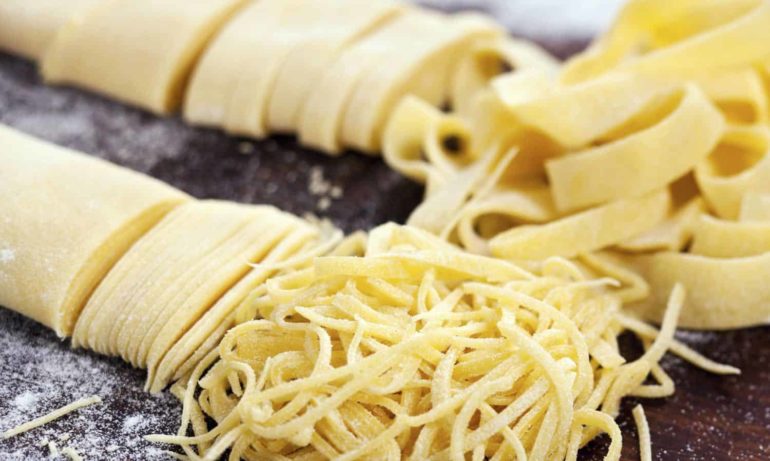A traditional staple of the Mediterranean Diet, pasta has played a central role in many cuisines throughout history and continues to be a crowd favorite, especially in the modern American cuisine. A complex carbohydrate and protein, pasta serves as a foundational component to a well-balanced and affordable meal.
To get a better understanding of pasta’s role in the modern diet and how it can contribute to a sustainable and affordable lifestyle, Food Tank had the opportunity to speak to Keri Gans and Elisa Zied, two nutritionists who serve on the Pasta Advisory Council.
Gans and Zied are both registered dietitian nutritionists with more than 35 years of collective experience working with a variety of consumers to develop real-world and no-nonsense approaches to nutrition and healthy lifestyles. Gans earned her bachelor’s in Marketing and Business Administration at Ohio University, later pursuing a masters in clinical nutrition at New York University. Zied received a bachelor’s in Psychology from the University of Pennsylvania and went on to earn a masters in clinical nutrition, also from New York University.
FT: Traditionally, what role has pasta played in diets and how has it changed over time?
KG: Pasta has been part of the Mediterranean Diet for centuries. At the base of the Mediterranean Diet pyramid, it’s the perfect staple to help build healthy meals. Over the years people have gotten away from traditional diets and traditional ways of eating pasta. Unfortunately today we see too many American adaptations of pasta; such as, creamy alfredo sauces, mac and cheese, and plus size portions. These are not part of the Mediterranean diet.
EZ: For years, pasta has traditionally been part of a healthy Mediterranean-style eating pattern and lifestyle (e.g. regular physical activity and shared family meals). But in the last couple of decades, carbohydrate confusion led many to mistakenly categorize pasta as being “bad for you.” Of course, the way people eat pasta has changed over time, with many Americans often consuming pasta with high-fat accompaniments and in oversized portions. The good news is there is a healthier way to include pasta in the diet. Choosing smaller portions of pasta and combining or serving it alongside nutrient-rich foods such as vegetables, beans, lean protein foods, and olive oil and adding herbs to other seasonings to the mix can help make pasta a staple you can feel good about.
FT: What role should pasta play in the modern diet?
KG: Pasta is a healthy, complex carbohydrate that is versatile and easy to make. It makes the perfect base for a healthy meal as it is a great carrier for healthy fats, vegetables, legumes and lean proteins. With proper portions and delicious, healthy pairings, pasta can be a key player in a modern, well-balanced, healthy diet.
EZ: Pasta can fit into a healthy, balanced diet. It is a pillar of the Mediterranean Diet—a dietary pattern endorsed by current federal dietary guidelines. The Mediterranean Diet also ranks number two overall according to the latest U.S. News & World Report’s recent “Best Diets” list. Studies have linked the Mediterranean diet with a longer and higher quality life as well as a lower risk of cancer and cardiovascular disease. Al dente pasta is also an optimal source of slowly digestible carbohydrates which are more available for gut bacteria, which in turn can keep the body healthy. A source of complex carbohydrate and protein, pasta pairs well with olive oil, legumes (beans and peas), vegetables, and lean protein foods. Because pasta and other grain-based foods have a lower environmental impact than some other foods, they can certainly fit into a nutrient-rich and varied diet. Barilla’s Pasta Recipe Builder is a great resource for people to simply craft healthy pasta recipes with 500 calories or less per serving for themselves and their families.
FT: How can pasta contribute to a sustainable, healthy, and affordable lifestyle?
KG: Pasta can help maximize energy stores in your body and give you “fuel” to sustain an increased level of physical activity. It is enriched with vitamins and minerals. Being plant-based, it has a low environmental impact and is a sustainable food choice. At less than two dollars per box, it’s affordable and available in almost all societies. Check out this recipe builder on passionforpasta.com for endless healthy pasta recipes that have 500 calories or less.
EZ: Pasta is a sustainable, affordable plant-based food that is tasty and so easy to incorporate in the diet. As Barilla’s Double Pyramid illustrates, pasta is one of the foods that can be frequently consumed to promote well-being while also benefiting the environment. It is a source of complex carbohydrates that fuels muscles and provides energy to the body. Pasta has a low Glycemic Index (GI)—essentially, the complex carbohydrates in pasta are digested more slowly than carbohydrates in rice, breads, and porridge-like products. Because the carbohydrates in pasta are digested more slowly, they have less of an effect on blood glucose and insulin levels than the carbohydrates in some other foods. Pasta also has a low Glycemic Index and is metabolized by the body more slowly than most other carbohydrates such as those in bread and rice and may help promote the feeling of satiety or fullness. This is especially true when eating pasta alongside lean protein foods e.g. skinless white meat chicken, lean beef, beans, or fish. Consuming low GI foods may help manage body weight and lower cholesterol and blood lipids. Keeping portions of pasta to about a cup or a cup and a half cooked depending on individual calorie/energy needs is a great way to incorporate nutrients (especially fiber if you’re eating whole wheat pasta) while allowing enough room calorie-wise for other nutrient-rich foods.















